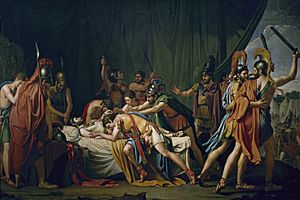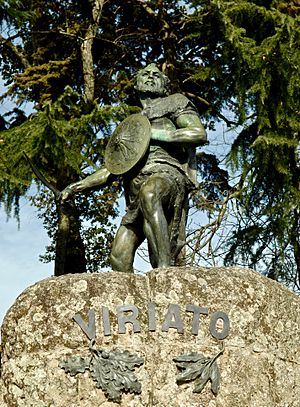Lusitanian War facts for kids
Quick facts for kids Lusitanian War |
|||||||||
|---|---|---|---|---|---|---|---|---|---|
 |
|||||||||
|
|||||||||
| Belligerents | |||||||||
| Celtic tribes vassal to Rome (Cynetes, Turdetani...) |
Lusitanian tribes Other Celtic tribes (Vettones, Gallaeci...) |
||||||||
| Commanders and leaders | |||||||||
| Servius Sulpicius Galba Gaius Vetilius Gaius Plancius Gaius Nigidius Fabius Aemilianus Fabius Servilianus Quintus Servilius Caepio Marcus Popillius Laenas |
Viriathus Tautalus Curius Apuleius Punicus Caesarus Caucenus |
||||||||
The Lusitanian War was a long fight between the Lusitanian tribes and the powerful Roman Republic. It happened in a part of ancient Hispania (which is now mostly Portugal and Spain) from 155 BC to 139 BC. The Lusitanians were trying to stop the Roman army from taking over their lands. This war was also called Pyrinos Polemos, meaning "the Fiery War," by the Greeks.
In 155 BC, the Lusitanians rebelled. They fought again in 146 BC before the Romans managed to calm things down for a bit. Around the same time, in 154 BC, another big war started in Hispania, called the Numantine War. This war, which lasted until 133 BC, was also very important in how the Romans eventually took control of the region.
Contents
A Look Back: Roman Arrival in Hispania
After the Second Punic War, the Roman Republic defeated Carthage, a powerful city that had colonies along the coast of the Iberian Peninsula. This was the first time the Romans really came into this area. It might also have been the first time Lusitanian fighters met Romans, as some Lusitanians worked as soldiers for Carthage during the Punic Wars.
Around 194 BC, the Romans started attacking Lusitanian lands. By 179 BC, they had mostly taken control of many tribes in the area. They even signed a peace treaty with the Lusitanians. But this peace would not last forever.
Early Battles and Roman Treachery (155 BC – 150 BC)
The Lusitanian War truly began in 155 BC. A Lusitanian leader named Punicus attacked lands that belonged to Roman allies. In this attack, the Lusitanians killed 6,000 Romans, including a Roman official called Terentius Varro. After this first win, the Lusitanians teamed up with another tribe, the Vettones. Together, they attacked a city called Blastophoenicians, which was a Phoenician settlement under Roman control. Punicus was killed during this attack, and Caesarus took his place as leader.
Rome sent a general named Mummius to fight Caesarus. At first, Caesarus was defeated. But as he ran away, he managed to turn the battle around, killing 9,000 Romans. Mummius then used his remaining 5,000 soldiers to surprise the Lusitanians, killing many of them.
Another group of Lusitanians, led by Caucenus, attacked the Cunei tribe, who were Roman allies. They captured a city called Conistorgis. Some Lusitanians even went into North Africa and attacked a city named Ocile. Mummius followed them, defeated the rebels, and ended the attack on Ocile. For this victory, Mummius was given a special parade in Rome called a triumph.
Marcus Atilius took over from Mummius. He fought the Lusitanians and captured their biggest city, Oxthracae. This made the nearby tribes, including the Vettones, so scared that they surrendered to Rome.
The Deceit of Galba
In the winter of 152 BC, the Lusitanians rebelled again. They attacked some Roman allies. Servius Galba, the new Roman general, quickly went to help. After an early victory, Galba was defeated while chasing the Lusitanian fighters. About 7,000 Romans were killed. Galba had to hide in a settlement called Carmone. He gathered his forces again and stayed in Conistorgis for the winter.
Another Roman general, Lucullus, attacked the Lusitanians, killing 4,000 of them. He then crossed into Lusitania. Galba joined him in attacking Lusitania.
The Lusitanians were worried by the Roman attacks. They sent messengers to Galba to make a new peace treaty, like the one they had with Atilius. Galba pretended to agree. He promised them good land if they would lay down their weapons. The Lusitanians believed him. They gathered in a plain, divided into three groups. Galba went to each group, told them to put down their arms, and then had his soldiers kill them all. Viriathus was one of the very few Lusitanians who managed to escape this terrible trick.
Viriathus: The Hero of Lusitania (148 BC – 140 BC)
In 148 BC, the Lusitanians gathered 10,000 fighters and attacked Turdetania. The Roman general Gaius Vetilius was sent to stop them. Vetilius had about the same number of soldiers and defeated the Lusitanians, who then asked for peace.
But as peace talks were happening, Viriathus reminded his people about Galba's betrayal, which he had seen himself. The Lusitanians chose Viriathus as their new leader. They planned a clever escape: they pretended to get ready for battle, then suddenly ran in all directions. They planned to meet up later in a city called Tribola. Vetilius attacked Viriathus directly, but Viriathus and 1,000 of his best men kept Vetilius busy for two days while the rest of the Lusitanians escaped safely. Viriathus then escaped the Romans and rejoined his army. Viriathus's success made other Celtic tribes, like the Gallaecians, decide to support him.
Viriathus became famous throughout the Roman world as a master of guerrilla warfare (hit-and-run tactics). People said he was like a hero from ancient stories. In 148 BC, Vetilius followed Viriathus to Tribola. Viriathus's forces set a trap for the Romans. About 6,000 Romans escaped, but the rest were killed or captured. Vetilius himself was killed because he was considered too old and fat to be a useful slave. The Romans asked for help from their Celtic allies, but 5,000 of these allied soldiers were also killed by the Lusitanians.
In 146 BC, Viriathus attacked Roman allies in Carpetania. General Gaius Plautius Hypsaeus arrived with 10,000 foot soldiers and 1,300 horsemen. But Viriathus defeated Plautius and then freely attacked other Roman areas.
Roman Generals Try to Stop Viriathus
In 145 BC, Rome sent a strong general, Quintus Fabius Maximus Aemilianus, to fight the Lusitanians. Since other wars were over, Maximus had a huge army: 15,000 foot soldiers and 2,000 horsemen. They had many small fights with the Lusitanians but no big battles.
In 144 BC, Maximus attacked Viriathus, making him run away and capturing two of his cities. Maximus chased Viriathus, killing many of his men, but Viriathus himself escaped. Maximus then went back to Rome. Quintus Pompeius Aulus took his place.
In 143 BC, Viriathus convinced several other Celtic tribes to fight the Romans. This led to the start of the Numantine War. Viriathus then had more small fights with Quintus. He hid in a mountain but later returned to battle, killing 1,000 of Quintus's men. Viriathus also drove out a Roman army from a town and attacked other Roman allies.
In 142 BC, Fabius Maximus Servilianus became the new Roman general. He brought two new legions and more allies, making his army 18,000 foot soldiers and 1,600 horsemen. He also got 300 horsemen and ten elephants from Africa. Maximus defeated Viriathus, but Viriathus still managed to kill 3,000 Romans and push them back to their camp. The Romans were saved by nightfall. Viriathus kept attacking, forcing them to retreat further. Viriathus went back to Lusitania. Instead of following him, Maximus attacked five towns that were allied with the Lusitanians. Then he marched into Lusitania.
While moving against Viriathus, Maximus was attacked by 10,000 Lusitanian soldiers led by Curius and Apuleius. Curius was killed in battle. Maximus then captured three Lusitanian cities. He captured about 10,000 men, killed 500, and sold the rest as slaves. Maximus's army rested in a town called Erisana. Viriathus managed to sneak into the town and defeat Maximus's armies. After this, Viriathus asked for the war to end.
The End of the War: Viriathus's Death (140 BC – 139 BC)

In 140 BC, Fabius Maximus Caepius took over from Maximus. Caepius complained to Rome that the peace treaty with Viriathus was not good enough for the Roman people. The Roman Senate first allowed Caepius to secretly fight Viriathus. Later, they decided to break the treaty and declare war on Viriathus. Caepius captured a town and won a battle against Viriathus, who escaped. Caepius then attacked the Vettones and Callaici tribes, destroying their lands.
After this, Viriathus sent his most trusted friends, Audax, Ditalcus and Minurus, to talk about peace with Caepio. But Caepio secretly paid them to kill Viriathus. Viriathus usually slept very little and always in his armor. He also allowed his friends to enter his tent at any time so he could be ready for battle quickly. His friends used this trust to sneak into his tent and kill him.
The Lusitanians were heartbroken and couldn't find out who killed him to get revenge. Instead, they held a huge funeral for Viriathus. They dressed him in special clothes, had parades, gladiator fights, and sang songs. A popular story says that the Roman general Caepio later executed the traitors, saying, "Rome does not pay traitors."
Tautalus was chosen to lead the Lusitanians after Viriathus. The Lusitanians tried to attack a city called Saguntum but failed. As they were crossing a river on their way back, they were defeated by Caepio and finally became Roman subjects. This marked the end of the Lusitanian War.
What Happened Next
After the Lusitanian War ended, there was a time of peace in Lusitania. However, the Lusitanians rebelled against the Romans again from 80 to 72 BC in the Sertorian War. During this time, they asked a Roman general who had been outlawed, Quintus Sertorius, to lead their fight against Rome.
The Lusitanian War, and especially the story of Viriathus, became a lasting symbol of Portuguese national identity and independence.
See also
 In Spanish: Guerras lusitanas para niños
In Spanish: Guerras lusitanas para niños
- Roman conquest of Hispania
- Romanization of Hispania
- Sertorian War
- History of Portugal
- Timeline of Portuguese history


